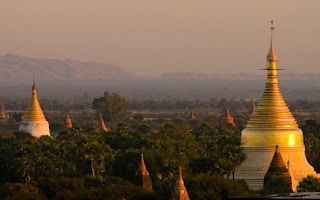A 6.8-magnitude earthquake struck central Myanmar’s Magway region early Wednesday, killing at least three people and damaging hundreds of buildings and Buddhist pagodas in an archaeological site in the nearby ancient city of Bagan.
A seven-year-old and a 15-year-old girl perished when a riverbank gave way in Yenanchaung township, south of Chauk, and an adult died and another was injured when a tobacco-processing factory collapsed in the town of Pakkoku, according to media reports.
“I heard the noise first and then someone said it was an earthquake,” a Magway township resident who gave her name as Myint told RFA’s Myanmar Service. “Then we ran out of house. I had such an experience when I was young.”
The quake, which occurred about 52 miles below the earth’s surface, hit around 4:34 p.m. local time about 15 miles west of the town of Chauk on the Irrawaddy River south of Bagan, according Myo Thant, secretary of the Myanmar Earthquake Committee.
Its tremors were felt as far away as Thailand, India and Bangladesh.
It caused one building in Pwint Phyu township and one in Magway township to collapse, sources said.
“This quake is almost similar to the Bagan earthquake in 1975,” Myo Thant told RFA. The temblor which occurred on July 8 of that year leveled and damaged many temples, some irreparably.
More than 2,000 temples and pagodas, many of which were built between the 10th and 13th centuries, dot Bagan, a popular tourist destination which sits in an earthquake zone in Mandalay region about 30 kilometers (19 miles) north of the epicenter of Wednesday’s temblor.
“
I heard the noise first and then someone said it was an earthquake. Then we ran out of house.
Myint, resident, Magway township, Myanmar
Damaged structures
The earthquake damaged 94 ancient pagodas in Bagan, including Sulamani, Dammangyi, Lawkananda, Mya Sati and Hteelo Minlo, as well as the ceiling of the upper house of the regional parliament in Magway, sources said.
“We have been compiling a list of damaged structures, though we haven’t completed it,” said Thein Lwin, deputy director general of the Bagan branch of the Ministry of Culture’s Archaeology and National Museum Department.
The Bagan Archaeological Zone is a main attraction for the country’s nascent but growing tourism industry, popular with religious pilgrims and tourists who come and scale the ancient Buddhist monuments to watch the sun set.
In fiscal year 2014-15, roughly 242,000 tourists who visited the zone generated about U.S. $4.1 million, according to a May 2015 article in the Myanmar Times which cited figures from the Bagan branch of the Archaeology and National Museum Department.
In 2014, the archaeological zone raised its admission fee to U.S. $20 from U.S. $10, the article said.
Copyright © 19908-2014, RFA. Used with the permission of Radio Free Asia, 2025 M St. NW, Suite 300, Washington DC 20036.

















